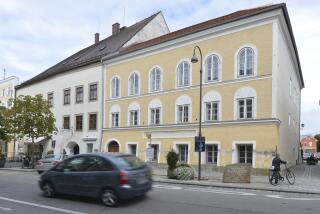Berlin’s Ruined Corridor of Power to Be Rebuilt
- Share via
EAST BERLIN — For decades, the East German communists left the piled rubble of Adolf Hitler’s bunker virtually untouched as a reminder of Nazism’s ignominious downfall.
Now the government has removed the bunker ruins so it can restore the street where the ostentatious government compound of Nazi Germany stood before being flattened by bombs at the end of World War II.
The rehabilitation of the former Wilhelmstrasse--named after the German kaisers--is part of a major renovation of the drab downtown district near the Berlin Wall as the city prepares for ceremonies marking the 750th anniversary this year of Berlin’s founding.
The street’s postwar name is Otto Grotewohl Strasse, after a co-founder of the Soviet-backed Socialist Unity Party that founded the East German state in 1949.
The reconstruction of Wilhelmstrasse “forms a bond with the historical tradition of Berlin Mitte (Center),” the city’s one-time capital district, the state-run press agency ADN said in a recent commentary.
Hitler’s Headquarters
Before 1945, the west side of Wilhelmstrasse was the site of Hitler’s grandiose marble headquarters, the chancellery built in 1938-39 under direction of his architect, Albert Speer. The building often was draped with huge swastika pennants that formed the backdrop for goose-stepping military parades.
It was in the study of his new chancellery on March 15, 1939, that Hitler browbeat the president of Czechoslovakia into accepting the German occupation of his country, which occurred the next day. That step hastened the onset of World War II.
Near the chancellery were the German Reich’s Foreign Office, the presidential palace, the swanky Adlon Hotel and posh apartments for Berlin’s diplomats and aristocrats.
In the chancellery garden, under 22 feet of concrete and earth, was the bunker where Hitler and mistress Eva Braun committed suicide as bombs shattered the street and much of Berlin in April, 1945. Aides burned the couple’s bodies in the garden shortly afterward.
Today, the stroller along the street sees an empty, uneven field on the western side, punctuated only by a remaining wing of the former Adlon Hotel, now used for government offices. Farther in the background is the heavily guarded Berlin Wall.
Shabby Office Buildings
On the street’s eastern side are a smattering of shabby government office buildings, including the former Nazi propaganda ministry and Hermann Goering’s air ministry, that survived the war.
“Some of the marble from the chancellery was used to build the subway station across the street from where the chancellery once was, and also for the Soviet war memorial” in East Berlin, said Winfried Suehlo, a West German diplomat here.
The long-delayed rehabilitation of Wilhelmstrasse was signaled last year when East German crews carted away the rubble that formed a mound 100 feet wide and about 10 feet high near the wall, Suehlo said in an interview.
The state-run East German press then announced a project to build modern apartments, smart shops and an 11-acre park along the street’s western side.
Construction workers are now starting to dig up the vacant lot for a multimillion-mark project charted for completion in 1990-91.
Symbolized Fascism’s Fall
“The GDR (East Germany) left Wilhelmstrasse vacant for decades because this fittingly symbolized the downfall of fascism and the hated Third Reich,” said Manfred Ackermann, cultural attache in West Germany’s Inter-German Relations Ministry.
“But the GDR has grown up a bit now and gained self-confidence. The rebuilding is meant to shore up the self-esteem of what is supposed to be a capital city,” said Ackermann.
Berlin was the capital of the German Reich from 1871 to 1945, the first two decades under Chancellor Otto von Bismarck, who had unified a fragmented nation.
More to Read
Sign up for Essential California
The most important California stories and recommendations in your inbox every morning.
You may occasionally receive promotional content from the Los Angeles Times.













